Similar presentations:
Source Segregation. Chris Darwin. Experimental Psychology. University of Sussex
1. Source Segregation
Chris DarwinExperimental Psychology
University of Sussex
2.
3. Need for sound segregation
• Ears receive mixture of sounds• We hear each sound source as having its own
appropriate timbre, pitch, location
• Stored information about sounds (eg
acoustic/phonetic relations) probably concerns a
single source
• Need to make single source properties (eg silence)
explicit
4. Making properties explicit
2000/yayayayay/
1000
Fo
240
130
Fo
• Single-source
properties not
explicit in input
signal
Formant freq. Hz
Making properties explicit
130
480
720
960 ms
on monotone
• eg silence
Fo
Formant freq. Hz
(Darwin &
Bethel-Fox, JEP:HPP
1977)
on alternating Fo
2000
/gagagagag/
1000
130
240
480
720
960 ms
NB experience of yodelling may alter your susceptibility to this effect
5. Mechanisms of segregation
• Primitive grouping mechanisms based ongeneral heuristics such as harmonicity and
onset-time - “bottom-up” / “pure audition”
• Schema-based mechanisms based on specific
knowledge (general speech constraints?) “top-down.
6. Segregation of simple musical sounds
• Successive segregation– Different frequency (or pitch)
– Different spatial position
– Different timbre
• Simultaneous segregation
–
–
–
–
Different onset-time
Irregular spacing in frequency
Location (rather unreliable)
Uncorrelated FM not used
7. Successive grouping by frequency
Bugandan xylophone music: “Ssematimba ne Kikwabanga”Track 7
Track 8
8. Not peripheral channelling
Streaming occurs for sounds– with same auditory excitation pattern, but
different periodicities
Vliegen, J. and Oxenham, A. J. (1999). "Sequential
stream segregation in the absence of spectral cues," J.
Acoust. Soc. Am. 105, 339-46.
– with Huggins pitch sounds that are only
defined binaurally
Carlyon & Akeroyd
9. Huggins pitch
"a faint tone"Frequency
Noise
∆ø
Interaural
phase difference
Time
2π
0
500 Hz
Frequency
10. Successive grouping by frequency
Successive grouping by spatial separationTrack 41
11. Successive grouping by spatial separation
Sach & Bailey - rhythm unmasking byITD or spatial position ?
Masker
Target • ITD=0, ILD = 0
Target • ITD=0, ILD = +4 dB
ITD sufficient
but, sequential
segregation by
spatial position
rather than by
ITD alone.
12. Sach & Bailey - rhythm unmasking by ITD or spatial position ?
Build-up of segregationHorse
-LHL-LHL-LHL-
-->
Morse
--H---H---H--L-L-L-L-L-L-L
• Segregation takes a few seconds to build up.
• Then between-stream temporal / rhythmic
judgments are very difficult
13. Build-up of segregation
Some interesting points:• Sequential streaming may require attention rather than being a pre-attentive process.
14. Some interesting points:
Attention necessary for build-up ofstreaming (Carlyon et al, JEP:HPP 2000)
Horse
-LHL-LHL-LHL-
-->
Morse
--H---H---H--L-L-L-L-L-L-L
• Horse -> Morse takes a few seconds to
segregate
• These have to be seconds spent attending
to the tone stream
• Does this also apply to other types of
segregation?
15. Attention necessary for build-up of streaming (Carlyon et al, JEP:HPP 2000)
Capturing a component from a mixtureby frequency proximity
A-B
A-BC
Freq separation of AB
Harmonicity & synchrony of BC
16. Capturing a component from a mixture by frequency proximity
Simultaneous groupingWhat is the timbre / pitch / location of
a particular sound source ?
Important grouping cues
• continuity
• onset time
(Old + New)
• harmonicity (or regularity of frequency
spacing)
17. Simultaneous grouping
Bregman’s Old + New principleStimulus: A followed by A+B
-> Percept of:
A as continuous (or repeated)
with B added as separate percept
18. Bregman’s Old + New principle
Old+New HeuristicA
M
A
M
M
B
A
M
M
B
A
MAMB
A
M
M
B
M
M
B
B
MAMB
19. Old+New Heuristic
PerceptM
20. Percept
frequencyGrouping & vowel quality
time
21. Grouping & vowel quality
Grouping & vowel quality (2)continuation removed from vowel
continuation not removed from vowel
frequency
frequency
captor
time
frequency
frequency
time
time
time
+
frequency
frequency
+
time
time
22. Grouping & vowel quality (2)
Bregman’s Old-plus-New heuristicfrequency
Onset-time:
allocation is subtractive not exclusive
time
+
+
time
frequency
Level-Independent
frequency
Level-Dependent
time
• Indicates importance of coding change.
23. Onset-time: allocation is subtractive not exclusive
Asynchrony & vowel quality490
8 subjects
F1 boundary (Hz)
No 500 Hz component
480
470
460
T
450
90 ms
440
0
80
160
240
Onset Asynchrony T (ms)
320
24. Asynchrony & vowel quality
Mistuning & pitchMean pitch shift (Hz)
1
vowel
complex
0.8
0.6
0.4
90 ms
0.2
0
-0.2
8 subjects
0
1
2
3
5
% Mistuning of 4th Harmonic
8
25. Mistuning & pitch
Onset asynchrony & pitchMean pitch shift (Hz)
1
±3% mistuning
8 subjects
0.8
vowel
complex
0.6
0.4
0.2
0
T
-0.2
90 ms
0
80
160
240
Onset Asynchrony T (ms)
320
26. Onset asynchrony & pitch
Some interesting points:• Sequential streaming may require attention - rather than
being a pre-attentive process.
• Parametric behaviour of grouping depends
on what it is for.
27. Some interesting points:
Grouping forEffectiveness of a parameter on grouping
depends on the task. Eg
• 10-ms onset time allows a harmonic to be
heard out
• 40-ms onset-time needed to remove from
vowel quality
• >100-ms needed to remove it from pitch.
28. Grouping for
Minimum onset needed for:Harmonic in vowel to be heard out:
c. 10 ms
40 ms
Harmonic to be removed from vowel:
Harmonic to be removed from pitch:
200 ms
29. Minimum onset needed for:
Grouping not absolute andindependent
of classification
classify
group
30. Grouping not absolute and independent of classification
Apparent continuityIf B would have masked if it HAD been there,
then you don’t notice that it is not there.
Track 28
31. Apparent continuity
Continuity & groupingHarmonic
1. Pulsing complex
Enharmonic
1. Pulsing high tone
2. Steady low tone
Group tones; then decide on continuity.
32. Continuity & grouping
Some interesting points:• Sequential streaming may require attention - rather than
being a pre-attentive process.
• Parametric behaviour of grouping depends on what it is for.
• Not everything that is obvious on an auditory
spectrogram can be used :
• FM of Fo irrelevant for segregation
(Carlyon, JASA 1991; Summerfield & Culling 1992)
33. Some interesting points:
Carlyon: across-frequency FM coherencefrequency
5 Hz, 2.5% FM
1
2
Harm
Inharmonic
2500
2000
1500
2500
2100
1500
3
Odd-one in 2 or 3 ? Easy
Impossible
Carlyon, R. P. (1991). "Discriminating between coherent and incoherent
frequency modulation of complex tones," J. Acoust. Soc. Am. 89, 329-340.
34. Carlyon: across-frequency FM coherence
Role of localisation cuesWhat role do localisation cues play in helping us to
hear one voice in the presence of another ?
• Head shadow increases S/N at the nearer ear (Bronkhurst &
Plomp, 1988).
– … but this advantage is reduced if high frequencies inaudible (B &
P, 1989)
• But do localisation cues also contribute to selectively
grouping different sound sources?
35. Role of localisation cues
Some interesting points:• Sequential streaming may require attention - rather than being a preattentive process.
• Parametric behaviour of grouping depends on what it is for.
• Not everything that is obvious on an auditory spectrogram can be used :
FM of Fo irrelevant for segregation
(Carlyon, JASA 1991; Summerfield &
Culling 1992)
• Although we can group sounds by ear, ITDs by
themselves remarkably useless for simultaneous
grouping. Group first then localise grouped object.
36. Some interesting points:
Separating two simultaneous soundsources
• Noise bands played to different ears
group by ear, but...
• Noise bands differing in ITD do not
group by ear
37. Separating two simultaneous sound sources
Segregation by ear but not by ITD(Culling & Summerfield 1995)
EE
AR
ear
AR
ITD
EE
AR
EE
delay
OO
ER
Task - what vowel is
on your left ? (“ee”)
% vowels identified
100
75
50
25
0
ear
ITD
Lateralisation cue
38. Segregation by ear but not by ITD (Culling & Summerfield 1995)
Two models of attentionAttend to common ITD
Peripheral filtering
into frequency
components
Establish ITD of
frequency
components
Attend to common
ITD across
components
Attend to direction of object
Peripheral filtering
into frequency
components
Establish ITD of
frequency
components
Group
components by
harmonicity,
onset-time etc
Establish direction
of grouped object
Attend to
direction of
grouped object
39. Two models of attention
Phase Ambiguity500 Hz: period = 2ms
R leads by 1.5 ms
L
L leads by 0.5 ms
R
500-Hz pure tone leading
in Right ear by 1.5 ms
L
Heard on Left side
cross-correlation peaks at +0.5ms and -1.5ms
auditory system weighted toone closest to zero
40. Phase Ambiguity
Disambiguating phase-ambiguity• Narrowband noise at 500 Hz with ITD of
1.5 ms (3/4 cycle) heard at lagging side.
•Increasing noise bandwidth changes
location to the leading side.
Explained by across-frequency consistency
of ITD.
(Jeffress, Trahiotis & Stern)
41. Disambiguating phase-ambiguity
Resolving phase ambiguityLeft ear actually lags by 1.5 ms
500 Hz: period = 2ms
L lags by 1.5 ms
L R
R
or L leads by 0.5 ms ?
Frequency of auditory filter Hz
R
300 Hz: period = 3.3ms
800
L lags by 1.5 ms
R
or L leads by 1.8 ms ?
Actual delay
600
400
200
-2.5
-0.5
1.5
Delay of cross-correlator ms
L
3.5
Cross-correlation peaks for noise delayed in one ear by 1.5 ms
42. Resolving phase ambiguity
Frequency (Hz)Segregation by onset-time
Synchronous
Asynchronous
0
0
800
600
400
200
400
Duration (ms)
80
400
Duration (ms)
ITD: ± 1.5 ms (3/4 cycle at 500 Hz)
43. Segregation by onset-time
Segregated tone changes locationPointer IID (dB)
20
0
R
-20
0
20
L
Complex
Pure
40
Onset Asynchrony (ms)
80
44. Segregated tone changes location
Frequency (Hz)Segregation by mistuning
In tune
Mistuned
800
600
400
200
0
400
Duration (ms)
0
80
400
Duration (ms)
45. Segregation by mistuning
Pointer IID (dB)Mistuned tone changes location
20 Positive
Negative
0
R L
-20
0 1
3
6
0 -1
Mistuning (%)
-3
Complex
Pure
-6
46. Mistuned tone changes location
Mechanisms of segregation• Primitive grouping mechanisms based on
general heuristics such as harmonicity and
onset-time - “bottom-up” / “pure audition”
• Schema-based mechanisms based on specific
knowledge (general speech constraints?) “top-down.
47. Mechanisms of segregation
Hierarchy of sound sources ?Orchestra
1° Violin section
Leader
Chord
Lowest note
Attack
2° violins…
Corresponding hierarchy of constraints ?
48. Hierarchy of sound sources ?
Is speech a single sound source ?Multiple sources of sound:
Vocal folds vibrating
Aspiration
Frication
Burst explosion
Clicks
Nama: Baboon's arse
49. Is speech a single sound source ?
Tuvan throat music50. Tuvan throat music
51. Tuvan throat music
Sine-wave speech: one is OK...(Bailey et al., Haskins SR 1977; Remez et al., Science 1981)
52. Sine-wave speech: one is OK... (Bailey et al., Haskins SR 1977; Remez et al., Science 1981)
SWS: but how about two?Onset-time & continuity only bottom-up cues
Barker & Cooke, Speech Comm 1999
53. SWS: but how about two?
Both approaches could be true• Bottom-up processes constrain alternatives
considered by top-down processes
e.g. cafeteria model (Darwin, QJEP 1981)
Evidence:
Onset-time segregates a
harmonic from a vowel, even if
it produces a “worse” vowel
time
(Darwin, JASA 1984)
+
time
54. Both approaches could be true
Low-level cues for separating a mixture oftwo sounds such as speech
Mixture
dB
frequency ->
Look for:
Source A
• harmonic series
dB
frequency ->
Source B
dB
frequency ->
• sounds starting at the
same time
55. Low-level cues for separating a mixture of two sounds such as speech
DFo between two sentences(Bird & Darwin 1998; after Brokx & Nooteboom, 1982)
Two sentences (same talker)
• only voiced consonants
• (with very few stops)
100
Masking sentence = 140 Hz ± 0,1,2,5,10 semitones
Target sentence Fo = 140 Hz
Task: write down target sentence
% words recognised
80
60
40
Perfect Fourth ~4:3
20
40 Subjects
40 Sentence Pairs
Replicates & extends Brokx & Nooteboom
0
0
2
4
6
8
Fo difference (semitones)
10
56. DFo between two sentences (Bird & Darwin 1998; after Brokx & Nooteboom, 1982)
Harmonicity or regular spacing?frequency
mistuned
adjust
time
Similar results for harmonic
and for linearly frequencyshifted complexes
Roberts and Brunstrom: Perceptual coherence of complex tones (2001)
J. Acoust. Soc. Am. 110
57. Harmonicity or regular spacing?
Auditory grouping and ICA / BSS• Do grouping principles work because they
provide some degree of stastistical
independence in a time-frequency space?
• If so, why do the parametric values vary
with the task?
58. Auditory grouping and ICA / BSS
Speechmusic























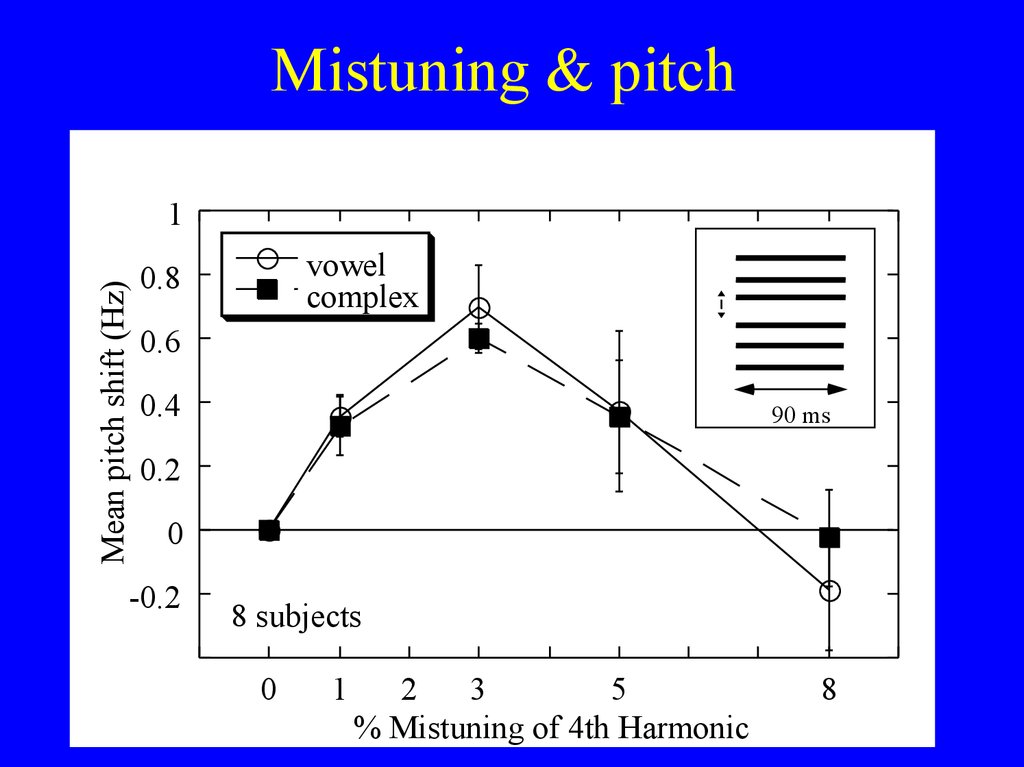






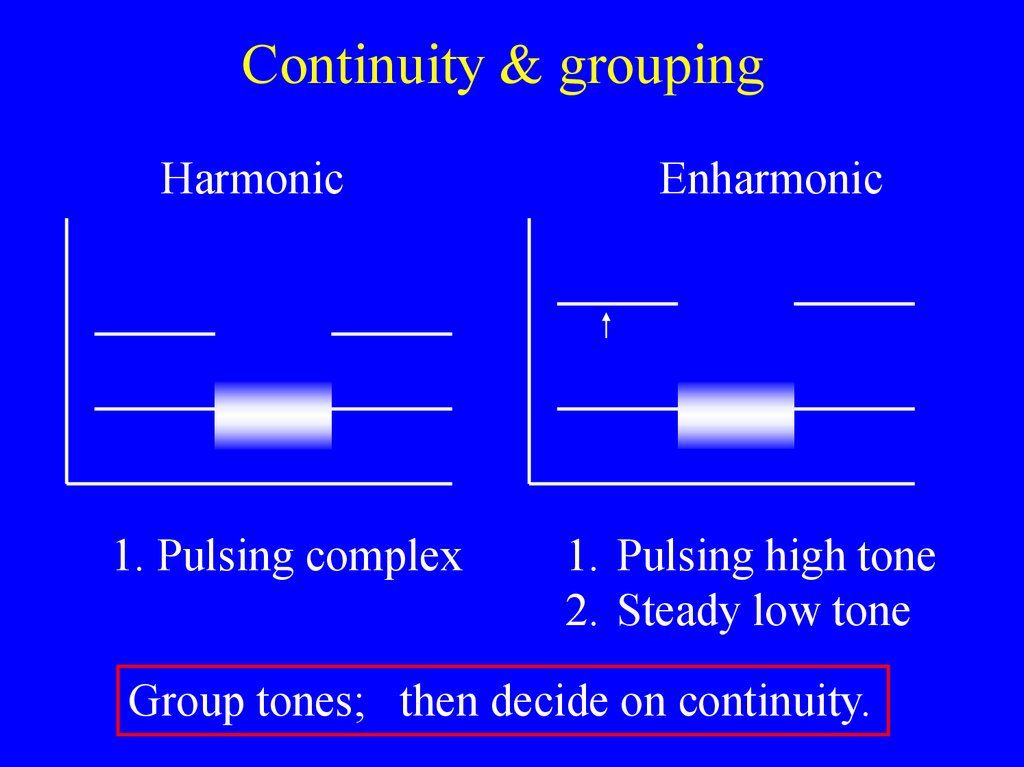















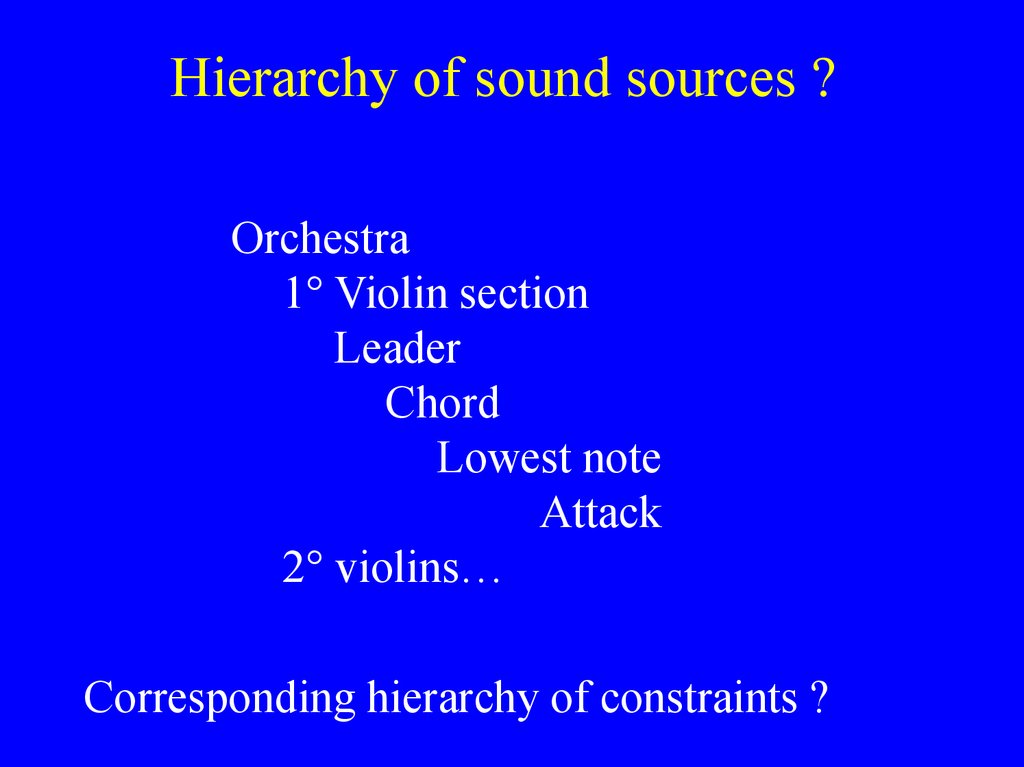
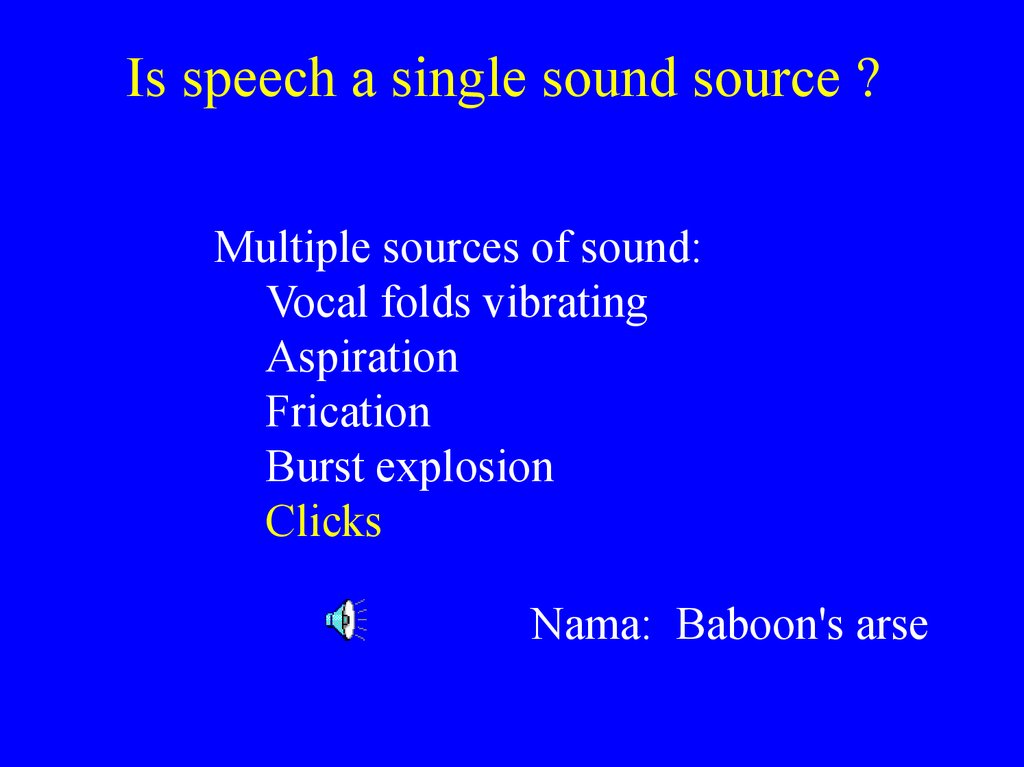


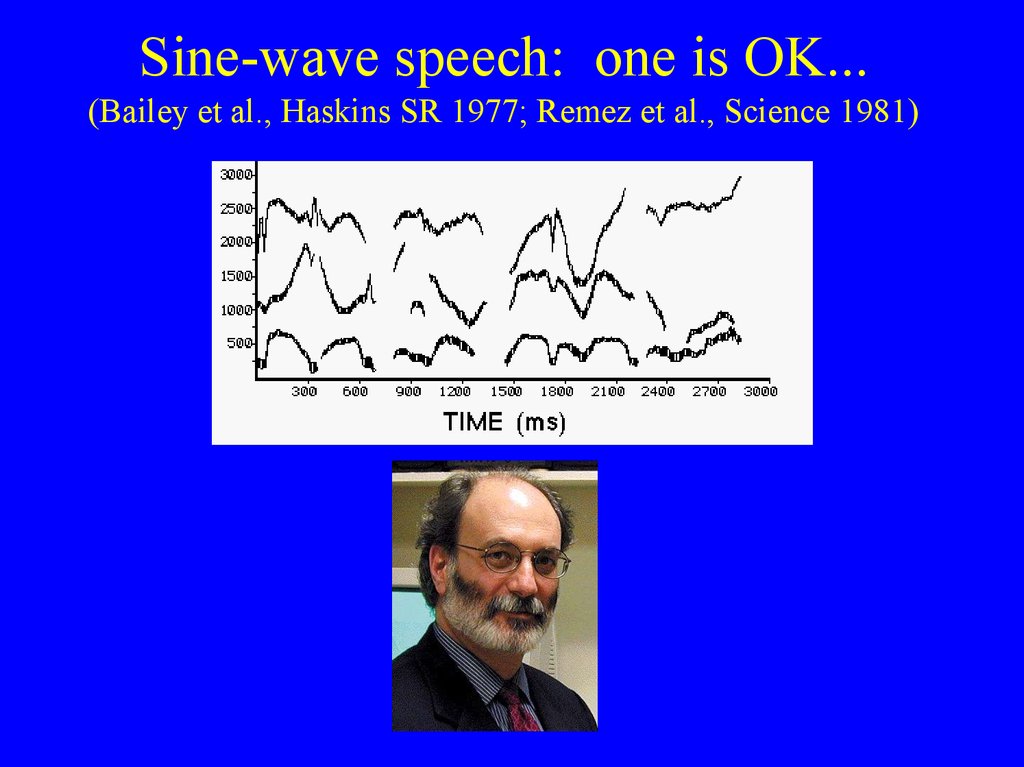


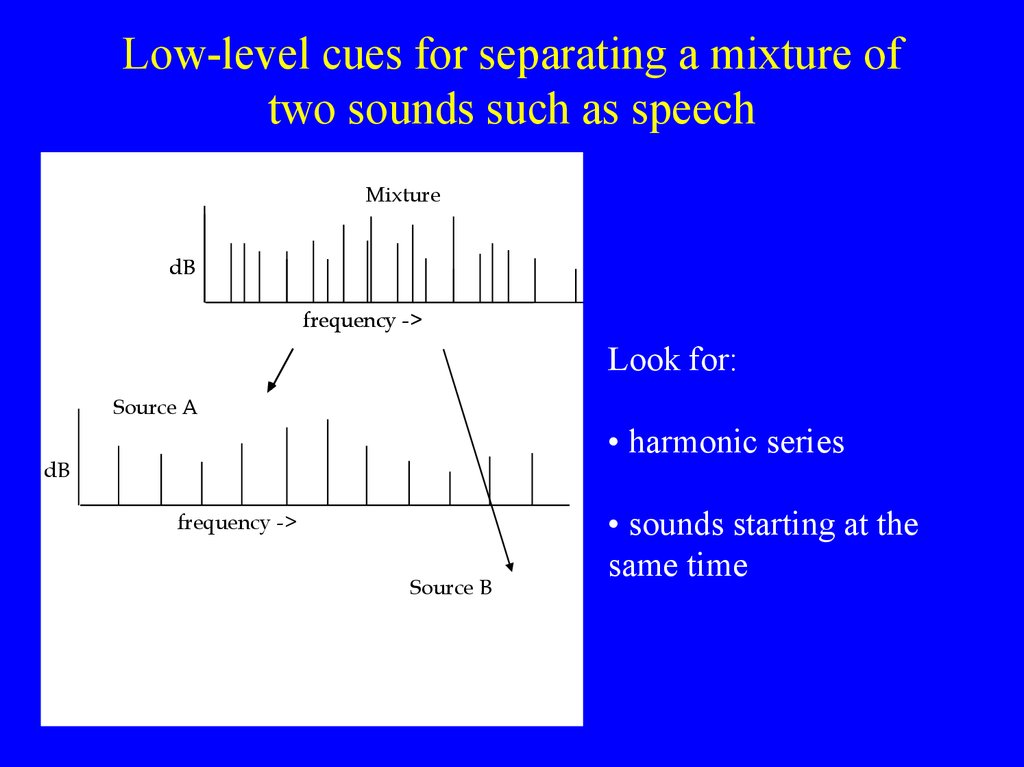



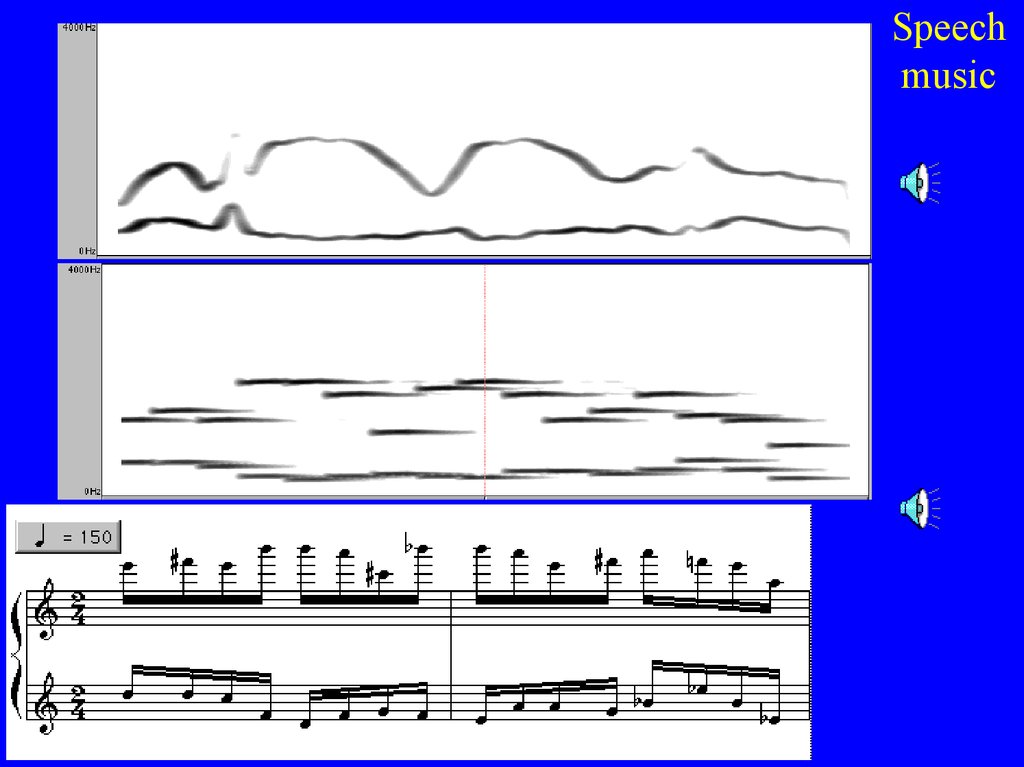


 psychology
psychology








